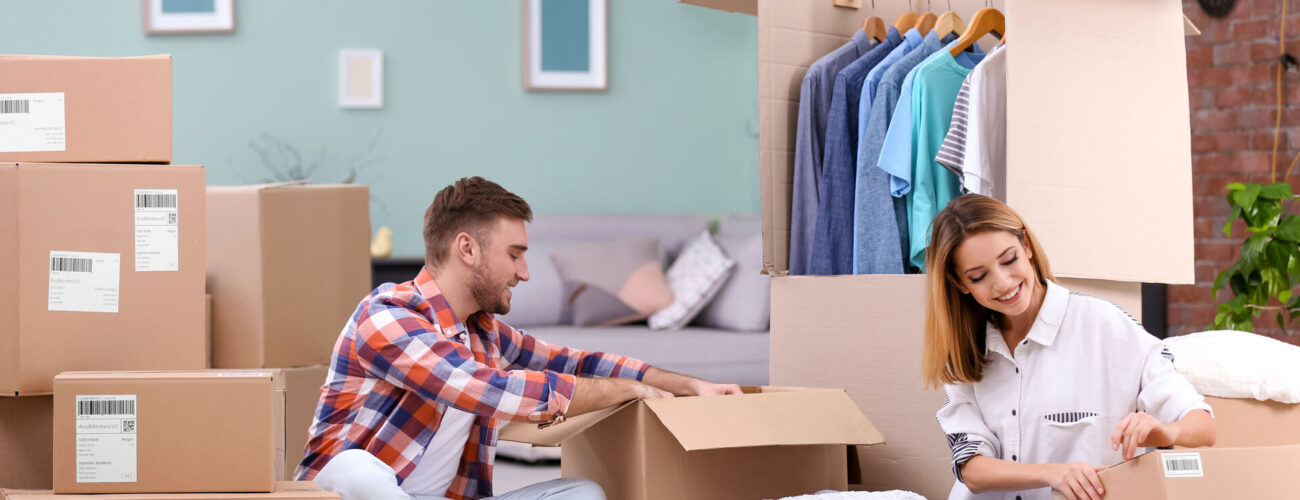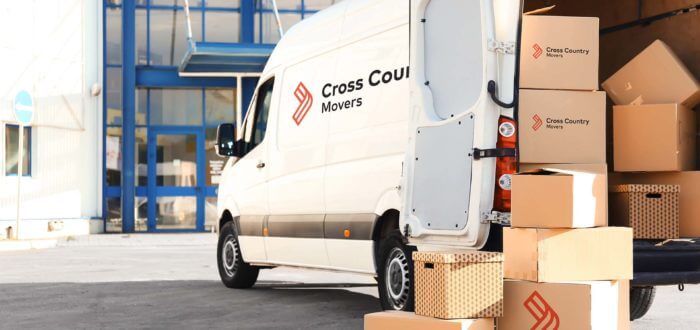

Packing Made Simple: The Easiest Way to Pack for a Move
Posted in Moving Essentials,Moving Tips & Tricks on May 2, 2023
Packing is usually a tiring process, so it’s important to find the easiest way to pack for a move and save your nerves along the road. It doesn’t matter how many times, how far, or for what purpose you must plan a move, packing will consume all of your energy if you don’t avoid your previous mistakes. With that in mind, let’s gather the needed materials and organize your belongings for moving without too much effort.
The Easiest Way to Pack for a Move and How to Make Packing Fun
Moving is difficult and can put you on the verge of a panic attack. The best route to avoid making mistakes and all the hassle is to hire long-distance movers. Plan ahead and start looking for cross-country moving services 4 to 8 weeks before the move. Get at least three quotes before choosing the best moving company for your needs. By hiring professionals, you can ensure that the moving company is liable for any damage done to your belongings during transit.
However, if you want to take boxing up into your own hands, make a thorough inventory list per room, note your current expenses, and determine how much packing material you need. Get a truck with a loading ramp. It may be more expensive, but it will save you time and sore muscles. If this seems like a chore, organizing a going-away party with a boxing-up theme might make the process more manageable or even fun. Keep reading for tips on how to have a simpler transition.

Purge Through Everything First
Every decluttering process should start with going through all your belongings and setting up rules to decide what to keep and what should stay behind. Downsizing for a move will help you with boxing everything up easier. Part with excess stuff, and sell some at a garage sale to boost your budget. To reduce the amount of perishables, simply donate unneeded food to charity.
For example, organizations such as Goodwill or the Salvation Army take all kinds of donations. Keep in mind that after you get rid of some belongings, there will be less stuff to move and unpack as well. On top of that, you can save extra money by selling things up and lowering the expenses of hiring cross-country movers.
Here is a video with tips on how to declutter your home before the move.
Set up a Dedicated Packing Station and Tools
It will be much simpler to store and arrange everything if you can find a room in your home that is clear and unoccupied, like an unused guest suite. The tool station should be spacious, taller if possible, and easily accessible. Set aside your dining room table, as it’s ideal for this occasion. When you’re done packing, leave markers, labels, and tape on the side.
Gather All the Necessary Supplies
Try to put all the needed boxing materials on a list before you hit a store, and you will save yourself some time. Get a variety of boxes and plastic containers with lids, packing paper, permanent markers, bubble wrap, colorful labels for each room, scissors, tape, a scalpel, and plastic or jumbo garbage bags. Keep in mind that you can use some household stuff lying around, like old sheets, towels, socks, and blankets.
Here are some additional tips to help you with boxing everything up.
- Weighting your items and packages – before you box everything up and load them onto the van, remember to put heavier things first and lighter objects on top.
- Use the right size storage – bulkier items should be packed in smaller to medium-sized bundles to prevent breaking or overpacking them.
- Zero space unused – fill an empty area with packing paper, towels, shirts, blankets, and clothing. Everything should be secured, well-stored, and balanced.
- Tape everything well – secure the top, edges, and bottom of the package with extra tape. Make a few wraps around everything to keep it from opening.
- Color coordinate labels with rooms – this will help you organize, pack and unpack everything. Be sure to properly label smaller plastic bags of hardware and boxes packed with fragile items.
Hiring Professional Movers to Help You With Packing Boxes
If you don’t know how many different packing materials you require, or it’s hard to determine how much of it you need, hire the expert packing service. They will bring the right tools and equipment to pack and load your stuff onto the moving truck. You don’t have to think about security straps in the back of a van, furniture dolly, packing materials, pads, and covers. They will know how to prepare and load your belongings in the best way possible.

Room-By-Room Packing System
This is the best method for boxing everything up efficiently. Start with writing an inventory list based on each room you will pack. Use open spaces for packing and organizing everything. This will help you with labeling and tracking your packages. With that in mind, we’ll give you a brief overview and tips on what to do in each area in order to have a stress-free move.
How to Store Your Kitchen and Dining Room Items
The easiest route to pack a kitchen for relocation is to decide to sell all the unnecessary bulkier items. All large appliances must be unplugged, disconnected from the gas line, cleaned, secured, and have their doors taped off and wrapped. Put them in their original packaging if you saved any. Put smaller appliances that you are planning to use immediately upon arrival in the laundry basket and buff them with clean clothes.
Any large pan or pot with lids can be used as storage for smaller spice containers or gadgets. Cover your plates with paper or put them in foam sleeves, and box them vertically to ensure them from cracking and chipping. Glassware and easily breakable objects should be wrapped separately, put in socks even, and secured in the box with dividers. Stack your knives and sharper utensils on paper and enfold them with kitchen towels. Secure everything with rubber bands and put them on their sides, never with sharp edges facing up.
Disassemble your table and chairs by removing the legs and hardware. Place them on a flat surface, stack them according to size, and wrap them tightly together. Put hardware in a sealable bag. If you are taking some of the kitchen cabinets with you, try removing shelves and doors. If that is not possible, tape the doors shut so they do not open during transport.
How to Pack Your Living Room and Breakable Pieces
Make a list of things you are planning to take with you. The best tactic to pack a TV, computer, and the rest of the electronics for moving is to put them in their original boxes, but if you don’t have any saved, enfold them well in the blankets. Take a picture of everything in the back and how all is connected. Mark cables for easier unboxing and setting up, and back up your computer’s hard drive
Whether or not you are moving large pieces of furniture, try to remove the legs, handles, or backs. Shrink wrap your cushions and pillows to save space. Clean your rugs and roll them tightly. Place them closer to the door of the truck and unload them first before any furniture is placed in the new home.
Mirrors, artwork, and framed family photos are very fragile, so you should mark them with an X over the glass to prevent them from breaking or wrapping them in softer materials. Edges should be secured with cardboard and fastened with tape and plastic wrap. Disassemble your lamps and take the lightbulbs out. Fold them separately in kitchen towels and store them in plastic containers. If you are boxing up your books, remember that a stack of books can get heavy pretty fast, so be sure not to overpack the box.
How to Box Up Your Home Office for Moving
A personal office is a place for patterns, well-learned habits, and organized chaos, usually filled with documents, significant mementos, and over-the-top ornaments. Start by going through your shelves filled with books and binders with important documents, contracts, plans, and transactions.
If you have file cabinets, the good news is that you can pack them exactly as they are by only securing the door with tape. All important documents should go with you to avoid losing or tearing them up in transport.
Office electronics are pricey. The best solution is to put them into their original packaging. Otherwise, think about putting money into packages specifically designed for computers, landline phones, TVs, faxes, and printing machines. Take photos of everything, especially how cables are connected.
How to Prepare When Packing the Bedroom and Wardrobe You Use Daily
Pack valuable stuff in a carry-on bag with locks and take it with you. If you are moving mattresses, wrap them in thin plastic to secure them from getting dirty. Cover up large pillows that can’t be boxed up to keep them from dusting or getting stained. Bedding can be used as additional wrapping and softening material. Disassemble the headboard and frame of your bed. Stack them on a flat surface and fold them in plastic along with the hardware.
Given that you are moving your dressers with drawers, go through your belongings and use the drawers as storage. Cover each dresser with plastic wrap to secure it from opening. Use suitcases for previously purged wardrobe. Roll clothes to save some space. Don’t remove everything from hangers – group them and secure them together so you can easily put them in specially designed boxes or larger bags.
Be sure to pack shoes in their original package or liquor boxes with dividers. Stuff them with socks or paper to prevent them from bending and losing shape. Clean your sneakers and flats before you put them in the suitcase. If you run out of space in your luggage, you can find cheap clear containers with lids to store them in.
How to Box Up Your Bathroom Products Correctly
Cleaning out the bathroom for the move is usually overlooked, but it is the easiest task. Many of the moving essentials you require will go in your personal suitcase, so try to put away bathroom items last.
Leave the first aid kit easily accessible. Secure open toiletries with masking tape so they do not leak and damage other things. Medications should be purged, packed, and labeled appropriately.
Moving Day and Packing to Move Last-Minute Items
If you hire experts, keep in mind that movers shouldn’t wait for you to finish packing and loading your car. Make a plan to have everything loaded and prepared for them to pick up. This will give you enough time to prepare portable coolers with food for the entire family, including meals, snacks, juices, and water rations.
Prepare your pets’ food, water, and area to stay in if you are relocating with them. Try to get up early so you may leave yourself some space for surprises. Create a to-do list on your phone or tablet so you can keep it with you all day. Mark off completed chores as you go.
To prevent mishaps, dress in comfortable but secure clothing for movement. Be careful with what you can handle and how you raise it if you have ongoing backache or a history of injuries. Get your luggage containing personal belongings away from the truck-related stuff. Go over everything with the movers and point out boxes that have fragile labels.
Bag With Personal Items
Every family member should have a carry-on bag with everything they’ll need for the initial period of the move, including their most-used clothes, toiletries, sleepwear, and some utensils you’ll require once you arrive at your new home.
In case you have hired a cross-country moving company, put all the necessary paperwork in the moving binder, as you may need to review or provide details on them during the trip, so have them ready. Also, take all your important documents with you. Bring your favorite dishes and a coffee maker. Charge your power banks, laptops, and phones before moving across the country.
If Organizing Boxes Exhaust You, We Can Help You Box Up
If boxing everything up for moving cross country is exhausting you, hiring long-distance moving professionals might just be the thing you need. Cross Country Movers offer an outstanding packing service, and we will assist you at each stage of your journey. Having us by your side will free up your schedule, giving you more time to spend with your family over this significant transfer. If you want to learn how to pack and get moving, give Cross Country Movers a call, and we will provide you with a superb, stress-free relocation experience.






